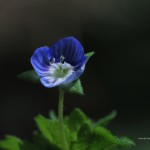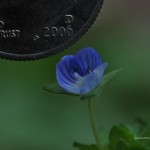 Low-growing plant with single tiny blue flowers in my backyard, amidst all the other weeds that crowd out any real grass. One person’s weed is another person’s wildflower. My personal definition of “wildflower” is “A flowering plant that grows without cultivation.” This weed is flowering, and we certainly aren’t cultivating it, although it’s growing more profusely than anything we are cultivating. The flower, when you look closely, is really quite pretty, and so warrants a photo and identification.
Low-growing plant with single tiny blue flowers in my backyard, amidst all the other weeds that crowd out any real grass. One person’s weed is another person’s wildflower. My personal definition of “wildflower” is “A flowering plant that grows without cultivation.” This weed is flowering, and we certainly aren’t cultivating it, although it’s growing more profusely than anything we are cultivating. The flower, when you look closely, is really quite pretty, and so warrants a photo and identification.
The first place I go when I don’t have any idea of a flower’s identification is to my copy of National Audubon Society Field Guide to North American Wildflowers–E: Eastern Region – Revised Edition. I checked there in the blue flower section, and pretty quickly spotted a close match – Corn Speedwell, Veronica arvensis. But while it was close, the leaf shape didn’t seem quite right, and the stamens in the book’s photo weren’t dark – although that could be a plant maturity issue. In any case, further research was warranted, and a confirmation elsewhere is always appropriate, so I went to the Internet.
A Google search for ‘corn speedwell’ turned up a link to IllinoisWildflowers.info, which is one of my favorite sites to use in identifying wildflowers due to their detailed descriptions and comparisons with similar plants. Much to my surprise I got a “not found” on the linked page. (The encouraging part of that is that even a place as esteemed as Illinois Wildflowers can apparently make an erroneous identification and later withdraw it.)
The next “corn speedwell” result in the Google search was a link to nearctica.com, a very nice site by Robert W. Poole with the lofty goal of providing “information on every species of living organism in North America.” As I started reading the description and looked at the drawing, I began to have my doubts. Then when I read that the flower for V. arvensis is sessile – no flower stem, I knew we had something different – the ones in my backyard have a pedicel that is nearly an inch long.
Back over on Illinois Wildflowers, a “speedwell” search on the site turned up a good candidate – Bird’s-eye speedwell – Veronica persica. It seems like a pretty good match, including the pedicel length so on for some confirmation. Over to Nearctica, the Bird’s-eye speedwell description seemed strange – the flowers were on a raceme, with the peduncle rising above the leaves. Confusion. Then I saw that Nearctica’s Bird’s-eye speedwell is V. chamaedrys, not V. persica. Bit by “the common name problem.” I find the V. persica page at Nearctica (03/08/2012 update: Nearctica.com has made a slight change in direction, and this page is no longer available.) It’s listed as “Persian Speedwell.” The description not only closely matches V. persica at Illinois Wildflowers, it closely matches my plant.
I’m almost ready to call it, but one more check. The Plants database at the US Department of Agriculture is a great resource to find out if a plant has been identified in a particular area. Oh, no! While V. persica is known in Georgia, it’s only in a couple of counties, and not in Walker County. It’s also not listed as being in Hamilton County, TN, either. V. arvensis is listed in Walker County, but not in Hamilton County. So I re-read the descriptions of both plants in both sites previously referenced, as well as other Internet sites. Incidentally, V. persica is listed as “birdeye speedwell” in USDA Plants.
The nearly sessile blossoms of V. arvensis rules that out in my mind, and V. persica remains my best guess. It won’t be the first time I think I’ve identified a wildflower in a county where it wasn’t listed in USDA Plants, and then to have it added to the USDA database as being in that county at a later date. Maybe this will be another one.
Veronica persica. Birdeye Speedwell. Or Persian Speedwell, which seems to more suitable, given the scientific name.



we found a similar speedwell on a lawn as we walked our dogs in NJ, except the center of the flower was yellow. Does anyone know what this wildflower is?
Richard –
I took a spin through the USDA Plants Database images for genus Veronica, and the only one I found that had a yellow-appearing center in any of the photos was Veronica cusickii, and it’s a western US species. Further, the images I saw with the yellow tint weren’t really definitively yellow; more of a yellow cast, and that could be some light/photograph trickery. Sorry I wasn’t able to help; maybe someone with greater expertise and experience will be able to get you some leads.
Thanks for visiting the site.
gcw
Great post and very useful!
Hi there!
I’m in north-central Pennsylvania and we have these “flowers” all over the place. They even grow up through the gravel in our driveway! This is an EXACT match to the
Persian/Birdseye Speedwell posted.
Thank you Gerry, your post and your research saved me quite a bit of time trying to identify this flower!
They started coming out about 2 weeks (around April 1st) and as of April 20th they are still going strong.
thank you for this awesome and detailed post!! we are in northeastern pa and have these all over the yard. i have been arguing with my husband about whether they were wildflower or weed…i love them so i am very happy that we don’t have to start pulling them out! thanks again!
Hi there! I was looking for the name of a tiny blue flower I see quite often here in Greece, and this must be it! I would say it’s an exact match to the flower at the top of your post. Persian Speedwell! I’ve put some pictures today in my blog. Have a look if you have time to see if you agree!
Thanks a lot for your nice post!
Regards from Greece!
Hi, Eva. Yes, that looks very much like Veronica persica to me. Thanks for the visit – from Greece!
gcw
Are the tiny blue flowers poisonous to humans?
I’m not aware of any poisonous affects, but of course some individuals might be allergic to any given plant. There are reports of edibility for some Veronica species. I doubt that it is poisonous.
Hello again, Gerry!
I need your help again…
I found a small purple flower a while ago, but I don’t know the name, and neither do my readers. Maybe you know?
http://evaiaten.blogspot.gr/2012/05/liten-lila-blomma-vit-pistill-gula.html
Sunny regards from Greece!
Eva
???
Eva – Thanks for the return visit. That flower looks like it might be in the Campanula genus – the Bellflowers. This link might help – http://www.greekmountainflora.info/Pages/PlantindexC.htm
Thank you for your article! We live in South-Central Pennsylvania and we have this growing all over the back hill of our yard. We’ve lost control with the weeds back there and are working hard to get it under control. However, my husband had no idea if this was a weed or something I had planted years ago. It does provide nice ground cover, but seems very invasive. I’m on the fence if we should pull it or not. At least now I know what we are dealing with. Thanks!
Thanks, Hilary, for the encouragement. I am glad you found this useful.
gcw
I too have this little Herb in my garden and up till now have been pulling it out I have since looked up its Medicinal Value, and it has a number of uses they are as follows.It has been found to have important components that the researchers believe may be valuable in combating cancer, also useful for soothing skin irritations, it is a diuretic and is used in Herbal cough preparations as an infusion or in a syrup form. Another so called weed I have been pulling out is Flick weed also known as Hairy bittercress part of the mustard family which is loaded with nutrients and nice in salads, so I think we have to investigate everything mother Earth has given us before we destroy it. Happy Gardening everyone Michele
I have just found a whole swath of these in our yard in southern California! In the shade under a pepper tree where it is very soggy for some reason (broken sprinkler?). So pretty and I’ve never seen them before. I went through the same discovery process you did. I wonder where the seeds came from…
Used this page as my primary for identification. Veronica Persica is here in Vegas.
Glad the site is useful, Lon. Thanks for the visit!
THANK YOU!!! I have been banging my head for months trying to find out the name of a wildflower in my yard. While my little flower does not sit so proudly away from the leaves as yours does it is definitely in the same family. I finally have a lead!
Not sure if this site is still active or not, but thought I’d give it a shot. I haven’t seen any descriptions mention the speedwell growing near or in water, though I believe I have photographed it along the banks of Oak Creek in Northern Arizona. It’s taken me a few months to even come this close to figuring out what it might be, so any assistance would be appreciated. There doesn’t appear to be a place to attach a photo, so I could email one if needed. Thanks!
Sarah – This does look like a Veronica (Speedwell) species to me. Check Veronica anagallis-aquatica – Water Speedwell. I don’t have it on USWildflowers.com, but you should be able to find more information elsewhere on the Internet.
– gcw
https://www.facebook.com/photo.php?fbid=10210323210502330&l=16cb31afff
https://www.facebook.com/photo.php?fbid=10210323217182497&l=f3f06fd20b
https://www.facebook.com/photo.php?fbid=10210323217342501&l=57fc57d8f1
Here are some links to a few of the photos I took of it. Please let me know if I’ve finally found out what it is.
Thanks again!
I am in Greenville, SC (piedmont area) and this plant grows here profusely. I noticed the reference to a yellow center. My plant has an area that is *almost* yellow. I have looked at it through strong glasses and cannot really identify the yellow, but it has a hint of it when you look at it from a short distance away. Perhaps because it is still so early in the season?
Hi GrannyD – I think the reference to a yellow center above was from someone trying to identify a similar flower. I wouldn’t expect to find a distinctly yellow center in V. persica. However, as you say, the pale center might look *almost* yellow.